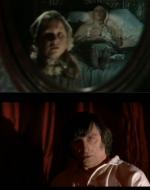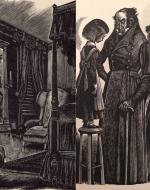Created by Sam Sasenarine on Wed, 11/04/2020 - 20:42
Description:
The Red Room is one of the first climactic scenes of Jane Eyre. This series will be addressing the imprisonment of young Jane and a supernatural encounter during a moment in her life where she was unhappy and mistreated by both her aunt, Mrs. Reed, and her children. The Red Room is significant to how Jane understands herself and becomes a recurring motif throughout the novel in which Jane must bear the trauma of the Red Room and learn to overcome eeriness and abuse as she grows into an independent woman. Through BBC series adaptations and Fritz Eichenberg's illustrations, the case addresses certain objects, colors, and uncanny "beings" that relate to Jane's development in the novel.
BBC drama series of Charlotte Brontë's Jane Eyre. Director Julian Amyes, 1983, London, United Kingdom.
This image is from the BBC 1983 drama series of Jane Eyre where young Jane wanders around the large red-room, observing the furniture. In this adaptation, there is a significant contrast between the mostly red furniture and white bedchamber. Additionally, the 2016 Norton edition of Charlotte Brontë's Jane Eyre (1847) explains this distinction, "Out of these deep surrounding shades rose high, and glared white, the piled-up mattresses and pillows of the bed, spread with a snowy Marseilles counterpane" (15). This adaptation of Jane Eyre is one of the few versions that display a contrast between young Jane (wearing white), the mostly furnished red-room, and white bedroom sheets and pillows. Since Jane recognizes the bed's color to be exceedingly different--referencing it as "glared white" and "snowy-- the importance of color is pivotal to the significance of Jane's isolation in the room. White may signify the innocence and purity of Jane--she wears white herself--paradoxical to the redness that may indicate darkness or evil of the room. Also, the mostly red room and white colors might suggest both the good and bad memories of the past. The room once belonged to Mr. Reed, who was a good man but died a tragic death on the white bed. In Jane's isolation, we can connect her "purity" and "goodness" to Mr. Reed--who wanted to take care of Jane as his own child and only hoped his wife would do the same after his death, but Mrs. Reed fails him.
BBC drama series version of Charlotte Brontë's Jane Eyre. Director Joan Craft, 1973, London, United Kingdom.
BBC drama series version of Charlotte Brontë's Jane Eyre. Director Susanna White, 2006, London, United Kingdom.
Two series adaptations display cinematic scenes of Mr. Reed. Although these are two different BBC adaptations, Mr. Reed is represented as a white and pale ghost. The Brontë sisters were known for their obsession with the gothic and supernatural. Charlotte's novel exemplifies this by showcasing the supernatural in moments of Jane's imprisonment. In the Norton 4th edition of Jane Eyre (1847), young Jane is paranoid in the dark red-room and mentions seeing a "light gleam on the wall" (18). Frightened, she runs to the door in desperation to be released, shouting that the light will "kill" her. In both BBC adaptations, Jane is watching Mr. Reed from a different perspective. The first image is of the 1973 version of Jane Eyre showing Mr. Reed's reflection in the mirror, lying on a bed resembling a transparent and sick, white ghost. The dread that Jane feels about turning around makes her freeze and watch the tormented figure in the mirror. Similarly, in the 2006 version, Mr. Reed's face is up-close and portrayed more humanized, but terrifying. His eye sockets are red and sagging--as if he hasn't slept in years. Also, he is glaring at Jane, creating a frightful response from her. Not all Jane Eyre adaptations portray the supernaturalness of Mr. Reed, but seeing them in both BBC versions is crucial to how restless his ghost appears. Jane briefly mentions her uncle as a generous man, explaining that Mrs. Reed promised to "maintain me as one of her own children" (17). Further on, Jane mentions that she "had heard of dead men, troubled in their graves by the violation of their last wishes and visiting the earth to punish the perjured and avenge the oppressed" (18). Perhaps, Mr. Reed's spirit in both screen shots looks ill and appalling because of the "unkept promise" of Mrs. Reed. Although he was a good and respectable man while alive, he is now unable to truly be at peace because his wife mistreats and abuses Jane.
"The Red Room." Jane Eyre. Written by Charlotte Brontë with wood engravings by Fritz Eichenberg, 1943, Random House, New York.
"Mr. Brocklehurst's Punishment." Jane Eyre. Written by Charlotte Brontë with wood engravings by Fritz Eichenberg, 1943, Random House, New York.
Fritz Eichenberg's wooden-engraved illustration of Jane in the red-room presents her sitting down on a cushion and staring above at the darkness of the room. The drawing contrasts with other red-room images in the series because of its expressionist portrayal of Jane's growing fear and isolation. Eichenberg's red-room illustration displays enlarged furniture surrounding Jane, including Mr. Reed's bedchamber. Also, compared to Eichenberg's other "young Jane" illustrations in Random House's 1943 version of Jane Eyre, Jane appears to look older than the typical "younger Jane" in this scene because of her long face, wavy hair, larger body, and wide eyes. Crafting Jane into an older girl may signify the recurring trauma of the red-room throughout her life. The red-room reappears in Jane's memories when she is being humiliated and "punished" for other characters' actions. First, it emerges at Lowood after Mr. Brocklehurst punishes Jane and forces her to stand on a stool, embarrassing her in front of all the school girls. In the Norton 4th edition of Charlotte's Jane Eyre (1847), Jane says, "...for I never forgot the, to me, frightful episode of the red-room… clutched my heart when Mrs. Reed spurned my wild supplication for pardon, and locked me a second time in the dark and haunted chamber" (66-67). Again, the red-room is brought up after Mr. Rochester reveals the truth to Jane about Bertha Mason. Here, she also feels betrayed and publicly humiliated, and fooled by Rochester for being deceitful about his past. She says, "...I was transported in thought to the scenes of childhood: I dreamt I lay in the red-room at Gateshead; that the night was dark, and my mind impressed with strange fear" (286). Eichenberg's uncanniness and older version of Jane in the red-room foreshadow future patterns of trauma that Jane experiences for the next formative years of her life. The severe mistreatment she endures from other characters doesn't allow her to move past the painful red-room memory till the very end of the novel.




